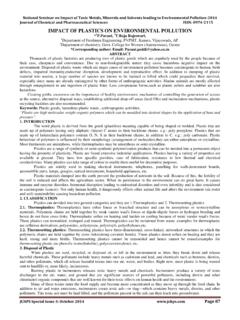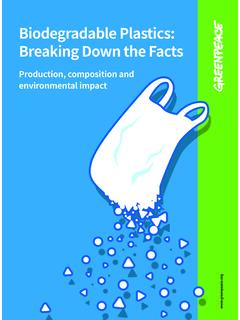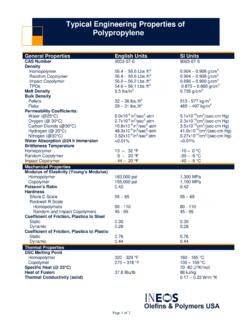Polymers And Plastics
Found 8 free book(s)5.33 Lecture Notes: Introduction To Polymer Chemistry
web.mit.eduClassification of polymers: Polymers (synthetic) 1) Thermoplastics (plastics) — linear, some cross -linking can be melted and reformed on heating a) Amorphous — no ordered structure b) Semi -crystalline — compo sed of microscopic crystallites — domains of crystalline structure. Can be ordered . Fibers (nylon, polyester)
IMPACT OF PLASTICS ON ENVIRONMENTAL POLLUTION
jchps.commade up of polymers having only aliphatic (linear) C atoms in their backbone chains. e.g.: poly propylene. Plastics that are made up of heterochain polymers contain O, N, S in their backbone chains, in addition to C. e.g.: poly carbonate. Plastic
Biodegradable Plastics Report - Greenpeace
www.greenpeace.orgagricultural resources, and polymers chemically synthesized using fossil-fuel resources (for examples, see Table 8.1). The different types of degradable plastics, even photo- and oxo-degradable plastics, are often marketed as “green”, “eco-friendly” and “natural”, or generally described as “biodegradable” materials.
TECHNICAL WHITEPAPER Low Temperature Properties of …
www.appstate.eduLow Temperature Properties of Polymers Introduction Most plastics at room temperature show their familiar properties of flexibility (a low Young’s modulus) and high resistance to cracking but when the temperature decreases this can change rapidly and many common plastics become brittle with low failure stresses.
Plastic Recycling Factsheet - Europa
circulareconomy.europa.eu• The fraction of recycled plastics used in modern cars can achieve up to 26.2 kg per car. Plastic is the second most commonly-used material in vehicles after metals13,14,15 2.3 Engineering plastics AUTOMOTIVE AND TRANSPORT SECTOR EEE SECTOR EuRIC - Plastic Recycling Factsheet 7 Metals Polymers Elastomers Glass/Ceramic Liquids
Unit 15 New 18.10.2018 - NCERT
ncert.nic.inpolymers are the backbone of four major industries viz. plastics, elastomers, fibres and paints and varnishes. The word ‘polymer’ is coined from two Greek words: poly means many and means unit or part. Themer term polymer is defined as very large molecules having
Polymer Matrix Composites - Princeton University
www.princeton.eduneering plastics, include some polyesters, poly - etherimide, polyamide imide, polyphenylene sul-fide, polyether-etherketone (PEEK), and liquid crystal polymers. They consist of long, discrete molecules that meltto a viscous liquid at the processing temperature, typically 500” to 700” F (260° to 3710 C), and, after forming, are cooled
Typical Engineering Properties of Polypropylene
www.ineos.comCoefficient of Friction, Plastics to Steel Static 0.30 0.30 Dynamic 0.28 0.28 Coefficient of Friction, Plastics to Plastic Static 0.76 0.76 Dynamic 0.44 0.44 Thermal Properties DSC Melting Point Homopolymer 320 - 329 °F 160 - 165 °C Copolymer 275 – 318 °F 135 – 159 °C Specific Heat (@ 23°C) 70 -80 J/°K/mol







